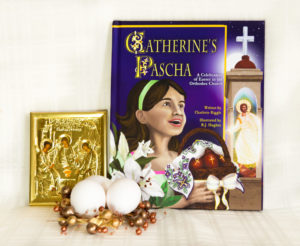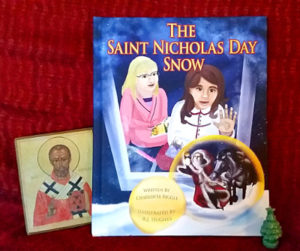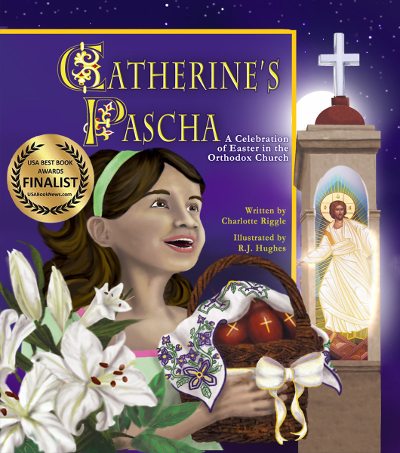The life of the Orthodox Church is carried through cycles of worship and prayer. If you follow these cycles, you’ll encounter St. Nicholas over and over. He has three feast days on the annual cycle of fixed feasts. And he’s also commemorated every Thursday, during the weekly cycle of prayers.
But why?
A poet captured by pirates
The answer to that question seems to begin in the year 842, when pirates captured a ship that was going from Constantinople to Rome and imprisoned the passengers on Crete. Among the passengers was a man named Joseph, a poet, who was travelling on official business. Joseph, following the example of St. Paul, accepted his chains with joy, and encouraged his fellow prisoners with hymns and prayers.
One night, a holy old man wearing a bishop’s stole appeared to Joseph in his prison cell. The man said he had just come from Myra, and he handed Joseph a scroll. “Read it,” he said. Joseph recognized the words as a prayer, so he sang the text: “Hasten, O Merciful One, and in compassion come quickly to our aid.”
The next morning, according to the oldest version of the story, the pirates released Joseph and sent him on his way to Constantinople. Other versions of the story said that the chains fell away immediately, and the mysterious bishop from Myra took him by the hand and flew with him to Constantinople, much as the Ghost of Christmas Present flew with Ebenezer Scrooge.
Hymns as icons
However it happened, Joseph’s imprisonment in Crete, and the role St. Nicholas played in his liberation, came to define the rest of his life. He gained his freedom just as the iconoclast controversy ended. He knew that smashing the icons had been meant to destroy the memory of the saints represented in them. And he wanted to be sure that every saint was remembered.
He wasn’t an artist, though. He was a poet. And so he began composing hymns and melodies for all the saints. A monastic community formed around him, and he set his monks to work researching the lives of all the saints, including those who were known by no more than their name and the date of their death. He wanted to know all that he could, so that he could record their lives in his songs.
Before long, he became known as Joseph the Hymnographer. He focused his efforts on the creation of canons, liturgical songs written in eight odes. Each ode was made of many verses that praised the saint and begged for the saint’s prayer and protection.
Saints and the weekly cycle of prayer
Joseph wasn’t the first to write canons, of course. There were already canons for Pascha and the great feasts. But Joseph was the first to address canons to particular saints. By the time he quit his hymn-writing, he had composed some 385 canons to saints.
And St. Nicholas figures prominently in that number. In addition to the hymns for specific saints, which were meant to be sung on the saint’s day each year, Joseph wrote a collection of canons for each day of the week. Already, churches were using a system of eight tones for their music. The first week after Pascha, all the hymns would be sung according to the first tone, the second week according to the second tone, and so on. In the ninth week after Pascha, the music would start over with the first tone.
So Joseph wrote a canon for each tone for each day of the week, 56 canons in all. He dedicated the canon for each day to a specific person or event. Sunday, of course was already a little Pascha, a celebration of the Resurrection of Christ. Wednesday and Friday were already consecrated to the Cross, and to the Betrayal and the Crucifixion. (This is why, to this very day, we keep Wednesdays and Fridays as fast days.)
To this, Joseph added canons to the angels and archangels on Monday. He honored the prophets, especially St. John the Forerunner and Baptist, in his canons for Tuesday. Saturday he dedicated to all the saints, especially the Mother of God, and to the memory of everyone who has died in the hope of resurrection and eternal life.
And every Thursday, he commemorated the Holy Apostles and St. Nicholas.
The communion of the saints
Theologically, the canons of the weekly cycle of prayer manifested the sanctification of time. By connecting each day of the week, and each day of the year, to the story of salvation, the canons brought things of earth into line with the things of heaven.
But they did more than that. The hymns that St. Joseph the Hymnographer wrote were accessible, not just to priests and monks, but to everyone. It didn’t matter how well educated you were, or how often you went to church. The hymns created a sense of deep intimacy with the saint. They were often written in the first person, and addressed directly to the saint. They made the communion of the saints feel palpable and real.
By giving St. Nicholas a place in the weekly cycle of prayer, St. Joseph the Hymnographer ensured that the people would sing the canons to St. Nicholas week after week, year after year. And it is this, more than anything, that gave St. Nicholas the place he holds in our hearts.
Read More
Looking for the real St. Nicholas: When you see old men in red robes with white beards, how do you know if they’re intended to be Santa Claus or St. Nicholas? Check out the symbols and tropes in this post, and you’ll (almost) always be able to tell.
Book activities with The Saint Nicholas Day Snow: Extend the book with cooking, crafts, academic activities, and Advent devotions.
Have a St. Nicholas party in July!: Because we celebrate St. Nicholas all year round, any time is a good time to have a St. Nicholas party!
For more information about St. Nicholas and St. Joseph the Hymnographer, read “Canon and Calendar: The role of a ninth-century hymnographer in shaping the celebration of the saints,” an article by Nancy Patterson Sevcenko, included in Byzantium in the Ninth Century: Dead or Alive?: Papers from the Thirtieth Spring Symposium of Byzantine Studies, Birmingham, March 1996.
Books by Charlotte Riggle

Catherine’s Pascha shares the joy of Pascha through the eyes of a child. Find it on Amazon or Bookshop.org.
![]()

The Saint Nicholas Day Snow is filled with friendship, prayer, sibling squabbles, a godparent’s story of St. Nicholas, and snow. Lots and lots of snow. Find it on Amazon or Bookshop.org.
![]()

In The Grace of Being There, women who are, or have been, single mothers share stories of their relationships with saints who were also single mothers. Charlotte’s story of the widow of Zarephath highlights the virtue of philoxenia. Find it on Amazon or Park End Books.



